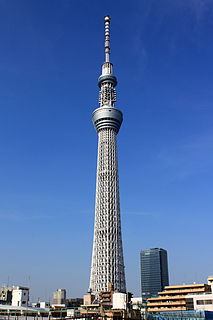 W
WA tower is a tall structure, taller than it is wide, often by a significant factor. Towers are distinguished from masts by their lack of guy-wires and are therefore, along with tall buildings, self-supporting structures.
 W
WThis is a list of extant towers that fulfill the engineering definition of a tower: "a tall human structure, always taller than it is wide, for public or regular operational access by humans, but not for living in or office work, and are self-supporting or free-standing, which means no guy-wires for support." The definition means the exclusion from this list of continuously habitable buildings and skyscrapers as well as radio and TV masts. Also excluded from this list because they are not designed for public or regular operational access are bridge towers or pylons, wind turbines, chimneys, transmission towers, sculptures and most large statues and obelisks.
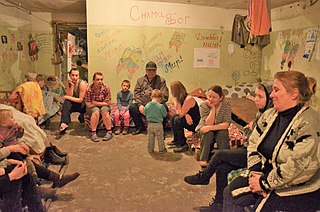 W
WAir raid shelters, also known as bomb shelters, are structures for the protection of non-combatants as well as combatants against enemy attacks from the air. They are similar to bunkers in many regards, although they are not designed to defend against ground attack.
 W
WA bell tower is a tower that contains one or more bells, or that is designed to hold bells even if it has none. Such a tower commonly serves as part of a church, and will contain church bells, but there are also many secular bell towers, often part of a municipal building, an educational establishment, or a tower built specifically to house a carillon. Church bell towers often incorporate clocks, and secular towers usually do, as a public service.
 W
WA Bilby tower is a type of steel survey tower used by the United States Coast and Geodetic Survey from 1927 to 1984. It is named after Jasper S. Bilby who designed it in 1926. In 1927, Herbert Hoover, the then Secretary of Commerce commended Bilby's tower "for its cost and time efficiency" and cited the surveyor's service as "essential to the United States government".
 W
WA Bismarck tower is a specific type of monument built according to a more or less standard model across Germany to honour its first chancellor, Otto von Bismarck. A total of 234 of these towers were inventoried by Kloss and Seele in 2007 but more have been discovered since making the total around 240. These towers were built between 1869 and 1934 and some 173 remain today. Quite a few of these towers, including all 47 based on Wilhelm Kreis's Götterdämmerung design, were built as so-called Bismarck Columns (Bismarcksäulen) or were converted into them. This description goes back to the Student Union's competition held in 1899, which was to encourage the erection of as many beacons as possible. But other Bismarck towers, e.g., those that were purely beacons with no observation function, were often called Bismarck columns.
 W
WA bomb tower is a lightly constructed tower, often 100 to 700 feet high, built to hold a nuclear weapon for an above ground nuclear test. The tower holds the bomb for the purpose of the investigation of its destructive effects and for the adjustment of measuring instruments, such as high-speed cameras. Normally, the bomb tower disintegrates completely on detonation due to the enormous heat of the explosion.
 W
WA bridge tower was a type of fortified tower built on a bridge. They were typically built in the period up to early modern times as part of a city or town wall or castle. There is usually a tower at both ends of the bridge. During the 19th century, a number of bridge towers were built in the Gothic Revival style – Tower Bridge in London is perhaps the best known example; however, many original medieval towers survive across Europe.
 W
WThe Burana Tower is a large minaret in the Chuy Valley in northern Kyrgyzstan. It is located about 80 km east of the country's capital Bishkek, near the town of Tokmok. The tower, along with grave markers, some earthworks and the remnants of a castle and three mausoleums, is all that remains of the ancient city of Balasagun, which was established by the Karakhanids at the end of the 9th century. The tower was built in the 11th century and was used as a template for other minarets. An external staircase and steep, winding stairway inside the tower enables visitors to climb to the top. It is one of the oldest architectural constructions in Central Asia.
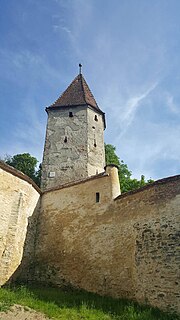 W
WThe Butchers' Tower is one of the nine towers located in the Citadel of Sighişoara, belonging to Mureș County in Romania. The Butcher's Tower was built in late 15th century. Originally, the tower was shaped in an eight-sided prism, but in the 16th century it was rebuilt on a hexagonal plan and was raised with the specific purpose of enlarge the field of view over the small bastion built right in front of it. The tower has three floors with five loopholes and the access was made, in the past, by the fortress wall gallery. Fortunately, the fire from 1676 did not affect the tower. The latter together with the bastion had a great importance in the defense of the western side of the Citadel.
 W
WCheomseongdae is an astronomical observatory in Gyeongju, South Korea. Cheomseongdae means star-gazing tower in Korean. Cheomseongdae is the oldest surviving astronomical observatory in Asia, and possibly even the world. It was constructed in the 7th century in the kingdom of Silla, whose capital was Seorabeol, or present-day Gyeongju. Cheomseongdae was designated as the country's 31st national treasure on December 20, 1962. Modeled on Baekje's Jeomseongdae, which now exists only in historical records, the Cheomseongdae influenced the construction of a Japanese observatory in 675, and Duke Zhou's observatory in China in 723.
 W
WA crooked spire, is a tower showing a twist and/or a deviation from the vertical. A church tower usually consists of a square stone tower topped with a pyramidal wooden structure, the spire. The spire is usually clad with slates or lead to protect the wood. Through accident or design the spire may contain a twist, or it may not point perfectly straight upwards. Some however have been built or rebuilt with a deliberate twist, generally as a design choice.
 W
WA drop tower or big drop is a type of amusement ride incorporating a central structure or tower. Drop towers vary in height, passenger capacity, lift type, and brake type. Many are custom-made, although there are some mass-produced designs. Riders experience free-fall initially, followed by rapid heavy deceleration.
 W
WThe term drum tower is used to refer to a tower in the center of an old Chinese city, housing signal drums. There was usually also a Bell tower nearby. For individual towers, see:Gulou and Zhonglou (Beijing) Drum Tower of Xi'an Drum Tower of Nanjing Bianjing Drum Tower
 W
WA Drum tower in Europe is a round tower that has a longer diameter length than height, resembling the shape of the musical instrument. Sometimes the term is used erroneously to describe typical round Norman defense towers or circular towers in general.
 W
WA fire control tower is a structure located near the coastline, used to detect and locate enemy vessels offshore, direct fire upon them from coastal batteries, or adjust the aim of guns by spotting shell splashes. Fire control towers came into general use in coastal defence systems in the late 19th century, as rapid development significantly increased the range of both naval guns and coastal artillery. This made fire control more complex. These towers were used in a number of countries' coastal defence systems through 1945, much later in a few cases such as Sweden. The Atlantic Wall in German-occupied Europe during World War II included fire control towers.
 W
WA fire lookout tower, fire tower or lookout tower, provides housing and protection for a person known as a "fire lookout" whose duty it is to search for wildfires in the wilderness. The fire lookout tower is a small building, usually located on the summit of a mountain or other high vantage point, in order to maximize the viewing distance and range, known as view shed. From this vantage point the fire lookout can see smoke that may develop, determine the location by using a device known as an Osborne Fire Finder, and call fire suppression personnel to the fire. Lookouts also report weather changes and plot the location of lightning strikes during storms. The location of the strike is monitored for a period of days after in case of ignition.
 W
WFlak towers were large, above-ground, anti-aircraft gun blockhouse towers constructed by Nazi Germany. There were 8 flak tower complexes in the cities of Berlin (3), Hamburg (2), and Vienna (3) from 1940 onwards. Other cities that used flak towers included Stuttgart and Frankfurt. Smaller single-purpose flak towers were built at key outlying German strongpoints, such as at Angers in France, Helgoland in Germany.
 W
WGhazni Minarets are two elaborately decorated minaret towers located in Ghazni city, central Afghanistan. They were built in middle of the twelfth century and are the only surviving elements of the mosque of Bahram Shah. The two minarets are 600 meters apart and lie in an open plain, north-east of Ghazni city.
 W
WA guard tower is any military tower used for guarding an area. These towers are usually operated by military personnel, and are structures built in areas of established control. These include military bases and cities occupied by military forces. This type of fortification is a variation on the tower incorporated into the walls of castles from history, and are, in the modern day, equipped with such facilities as heavier weapons than those carried by infantry and searchlights.
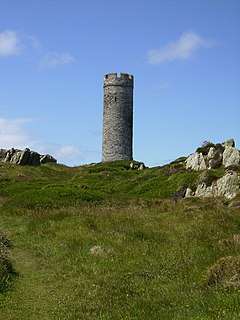 W
WThe Herring Tower is situated on the Langness Peninsula in the south of the Isle of Man. It was built by Thomas Brine in 1823. The tower was built as a daymark and was based on the style of the tower of Peel Castle. Since 1991 the Herring Tower has been protected as a registered building.
 W
WKiek in de Kök is an old Low German nickname for towers, mainly those that formed parts of town fortifications. They gained the name from the ability of tower occupants to see into kitchens of nearby houses. Due to the history of the Hanseatic League and the Teutonic Order, towers far outside modern Germany also bear this name, such as those in Gdańsk and Tallinn.
 W
WLa Tour Eiffel is a drop tower of the Hopi Hari amusement park in Vinhedo, São Paulo. It opened along with the park on November 30, 1999. The tower lets participants enter into free fall from a height of 69.5 meters, or 228 feet at a speed of approximately 94 km/h (58.41 mph).
 W
WIn architecture, the lantern tower is a tall construction above the junction of the four arms of a cruciform (cross-shaped) church, with openings through which light from outside can shine down to the crossing. Many lantern towers are usually octagonal, and give an extra dimension to the decorated interior of the dome.
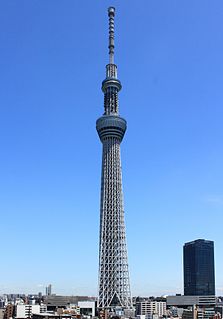 W
WA lattice tower or truss tower is a freestanding vertical framework tower. This construction is widely used in transmission towers carrying high voltage electric power lines, in radio masts and towers and in observation towers. Its advantage is good shear strength at a much lower weight than a tower of solid construction would have as well as lower wind resistance. In structural engineering the term lattice tower is used for a freestanding structure, while a lattice mast is a guyed mast supported by guy lines. Lattices of triangular (3-sided) cross-section are most common, particularly in North America. Square lattices(4-sided) are also widely used and are most common in Eurasia. Lattice towers are often designed as either a space frame or a hyperboloid structure.
 W
WThis article lists some but by no means all of the oldest known minaret towers in the world.
 W
WA mast radiator is a radio mast or tower in which the metal structure itself is energized and functions as an antenna. This design, first used widely in the 1930s, is commonly used for transmitting antennas operating at low frequencies, in the LF and MF bands, in particular those used for AM radio broadcasting stations. The conductive steel mast is electrically connected to the transmitter. Its base is usually mounted on a nonconductive support to insulate it from the ground. A mast radiator is a form of monopole antenna.
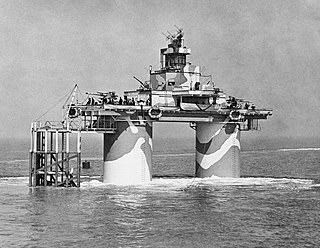 W
WThe Maunsell Forts are armed towers built in the Thames and Mersey estuaries during the Second World War to help defend the United Kingdom. They were operated as army and navy forts, and named after their designer, Guy Maunsell. The forts were decommissioned in the late 1950s and later used for other activities including pirate radio broadcasting. One of the forts is managed by the unrecognised Principality of Sealand; boats visit the remaining forts occasionally, and a consortium called Project Redsands is planning to conserve the fort situated at Red Sands.
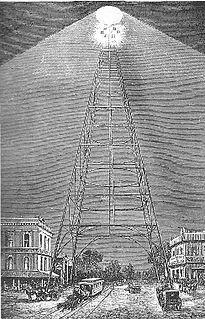 W
WA moonlight tower or moontower is a lighting structure designed to illuminate areas of a town or city at night.
 W
WThe Musalla Minarets of Herat are five huge ruined minaret towers in Herat city, western Afghanistan. The minarets and the complex were built by Queen Gawhar Shad in 1417.
 W
WThe Amundsen-Nobile Climate Change Tower (CCT) is a 34-meter research tower installed in Ny-Ålesund, Svalbard, Norway, for the study of various physical parameters in the boundary layer of the lower troposphere.
 W
WA pagoda is a tiered tower with multiple eaves common to China, Japan, Korea, Vietnam and other parts of Asia. Most pagodas were built to have a religious function, most often Buddhist but sometimes Taoist, and were often located in or near viharas. The pagoda traces its origins to the stupa of ancient India.
 W
WA partially guyed tower is a tower structure which consists of a free-standing basement, in most cases of concrete or of lattice steel, with a guyed mast on the top. The anchor basements of the guyed mast can be on the top of the tower or on the ground.
 W
WThe Maunsell Forts are armed towers built in the Thames and Mersey estuaries during the Second World War to help defend the United Kingdom. They were operated as army and navy forts, and named after their designer, Guy Maunsell. The forts were decommissioned in the late 1950s and later used for other activities including pirate radio broadcasting. One of the forts is managed by the unrecognised Principality of Sealand; boats visit the remaining forts occasionally, and a consortium called Project Redsands is planning to conserve the fort situated at Red Sands.
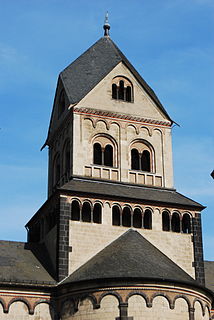 W
WThe Rhenish helm is a type of spire typical of Romanesque church architecture of the historic Rhineland.
 W
WA spire is a tall, slender, pointed structure on top of a roof or tower, especially at the summit of church steeples. A spire may have a square, circular, or polygonal plan, with a roughly conical or pyramidal shape. Spires are typically built of stonework or brickwork, or else of timber structure with metal cladding, ceramic tiling, shingles, or slates on the exterior.
 W
WA crooked spire, is a tower that, through accident or design, contains a twist or does not point perfectly straight upwards. There are about a hundred bell towers of this type in Europe.
 W
WA staircase tower or stair tower is a tower-like wing of a building with a circular or polygonal plan that contains a stairwell, usually a helical staircase.
 W
WThe stilt tower is a special type of Medieval church tower, concentrated in Djursland peninsula and neighbouring regions of Danish Jutland.
 W
WThe tallest structure in the world is the Burj Khalifa skyscraper at 829.8 m (2,722 ft). Listed are guyed masts, self-supporting towers, skyscrapers, oil platforms, electricity transmission towers, and bridge support towers. This list is organized by absolute height. See List of tallest buildings and structures, List of tallest freestanding structures and List of tallest buildings and List of tallest towers for additional information about these types of structures.
 W
WThis is a part of the list of tallest structures in the world, past and present of any type.
 W
WThe Albert Tower on the Isle of Man is a historic monument which is one of Isle of Man's Registered Buildings. It was registered on 27 January 2003 as number 214.
 W
WA crane is a type of machine, generally equipped with a hoist rope, wire ropes or chains, and sheaves, that can be used both to lift and lower materials and to move them horizontally. It is mainly used for lifting heavy things and transporting them to other places. The device uses one or more simple machines to create mechanical advantage and thus move loads beyond the normal capability of a human. Cranes are commonly employed in the transport industry for the loading and unloading of freight, in the construction industry for the movement of materials, and in the manufacturing industry for the assembling of heavy equipment.
 W
WA tower mill is a type of vertical windmill consisting of a brick or stone tower, on which sits a wooden 'cap' or roof, which can rotate to bring the sails into the wind.
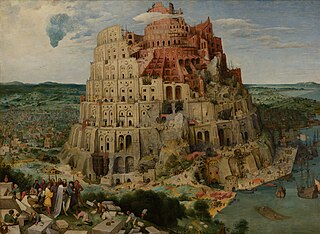 W
WThe Tower of Babel narrative in Genesis 11:1–9 is an origin myth meant to explain why the world's peoples speak different languages.
 W
WThe Tower of Elahbel was a four-storey sandstone tower tomb near the ancient city of Palmyra in Syria. The tower was one of several built outside the city walls of Palmyra, in an area known as the Valley of the Tombs. The tower was important in the history of textiles: fragments of very early Chinese silk yarns, dated to the 1st century AD, were discovered in the tombs at the tower. The tower was demolished using explosives by the Islamic State of Iraq and the Levant in August 2015.
 W
WTowerkill is a phenomenon in which birds are killed by collisions with antenna towers. In poor visibility, birds may simply fly into the guy-wires. But night illuminations around the towers can also disrupt migration patterns, with disoriented birds colliding with the structure. Research indicates that blinking lights can reduce deaths without diminishing visibility by aircraft.
 W
WThe Uzgen Minaret also spelled as Özgön Minar or Uzgend Minaret is an 11th-century minaret tower located in Uzgen, Kyrgyzstan. It forms part of the ancient ruins in Uzgen along with three well preserved mausoleums located nearby. Uzgen Minaret is a 27.5 metre tall tapering tower, with an 8.5 metre base diameter, reducing to 6.2 metres at the top.
 W
WA water tower is an elevated building supporting a water tank constructed at a height sufficient to pressurize a water distribution system for the distribution of potable water, and to provide emergency storage for fire protection. Water towers often operate in conjunction with underground or surface service reservoirs, which store treated water close to where it will be used. Other types of water towers may only store raw (non-potable) water for fire protection or industrial purposes, and may not necessarily be connected to a public water supply.